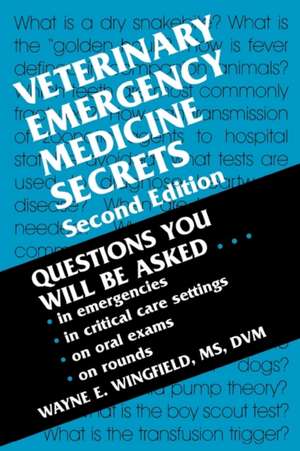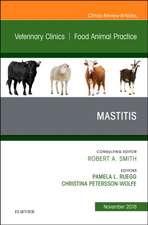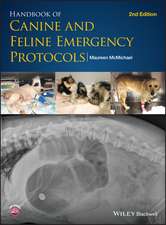Veterinary Emergency Medicine Secrets: Secrets
Autor Wayne E. Wingfielden Limba Engleză Paperback – 12 oct 2000
importance of emergency medicine and critical care in veterinary medicine, have helped
make this one of the best-selling books in The Secrets Series and in veterinary medicine
and critical care. Dr. Wingfield is one of the preeminent authorities in this field, and the
new edition is completely revised and updated, featuring a number of new authors,
with new chapters on disaster medicine and the transfusion trigger. Critical care
management of dogs and cats are also covered.
Din seria Secrets
-
 Preț: 116.28 lei
Preț: 116.28 lei - 27%
 Preț: 240.54 lei
Preț: 240.54 lei - 22%
 Preț: 288.38 lei
Preț: 288.38 lei - 5%
 Preț: 374.94 lei
Preț: 374.94 lei - 23%
 Preț: 265.49 lei
Preț: 265.49 lei - 5%
 Preț: 376.22 lei
Preț: 376.22 lei - 5%
 Preț: 331.09 lei
Preț: 331.09 lei - 24%
 Preț: 316.18 lei
Preț: 316.18 lei - 24%
 Preț: 188.73 lei
Preț: 188.73 lei - 27%
 Preț: 229.10 lei
Preț: 229.10 lei - 26%
 Preț: 285.31 lei
Preț: 285.31 lei - 27%
 Preț: 224.74 lei
Preț: 224.74 lei - 23%
 Preț: 266.41 lei
Preț: 266.41 lei - 5%
 Preț: 355.74 lei
Preț: 355.74 lei - 23%
 Preț: 294.07 lei
Preț: 294.07 lei - 25%
 Preț: 292.91 lei
Preț: 292.91 lei - 26%
 Preț: 230.11 lei
Preț: 230.11 lei - 26%
 Preț: 200.87 lei
Preț: 200.87 lei - 5%
 Preț: 376.25 lei
Preț: 376.25 lei - 25%
 Preț: 292.05 lei
Preț: 292.05 lei - 26%
 Preț: 244.81 lei
Preț: 244.81 lei - 25%
 Preț: 246.21 lei
Preț: 246.21 lei - 24%
 Preț: 206.45 lei
Preț: 206.45 lei - 22%
 Preț: 242.69 lei
Preț: 242.69 lei - 24%
 Preț: 231.06 lei
Preț: 231.06 lei - 25%
 Preț: 316.30 lei
Preț: 316.30 lei - 28%
 Preț: 206.06 lei
Preț: 206.06 lei - 5%
 Preț: 271.55 lei
Preț: 271.55 lei - 27%
 Preț: 240.80 lei
Preț: 240.80 lei - 27%
 Preț: 215.05 lei
Preț: 215.05 lei -
 Preț: 110.21 lei
Preț: 110.21 lei -
 Preț: 157.38 lei
Preț: 157.38 lei -
 Preț: 89.99 lei
Preț: 89.99 lei -
 Preț: 105.77 lei
Preț: 105.77 lei -
 Preț: 100.77 lei
Preț: 100.77 lei -
 Preț: 107.30 lei
Preț: 107.30 lei - 5%
 Preț: 469.89 lei
Preț: 469.89 lei - 5%
 Preț: 336.17 lei
Preț: 336.17 lei - 5%
 Preț: 446.50 lei
Preț: 446.50 lei - 5%
 Preț: 321.91 lei
Preț: 321.91 lei - 5%
 Preț: 477.81 lei
Preț: 477.81 lei - 24%
 Preț: 269.72 lei
Preț: 269.72 lei - 5%
 Preț: 461.65 lei
Preț: 461.65 lei - 5%
 Preț: 482.04 lei
Preț: 482.04 lei - 5%
 Preț: 497.64 lei
Preț: 497.64 lei - 5%
 Preț: 396.51 lei
Preț: 396.51 lei - 5%
 Preț: 438.05 lei
Preț: 438.05 lei - 5%
 Preț: 481.11 lei
Preț: 481.11 lei - 5%
 Preț: 486.79 lei
Preț: 486.79 lei
Preț: 488.61 lei
Preț vechi: 514.32 lei
-5% Nou
Puncte Express: 733
Preț estimativ în valută:
93.51€ • 97.26$ • 77.20£
93.51€ • 97.26$ • 77.20£
Carte tipărită la comandă
Livrare economică 14-28 aprilie
Preluare comenzi: 021 569.72.76
Specificații
Public țintă
Veterinarians, Veterinary StudentsCuprins
ILIFE-THREATENING EMERGENCIES
1. Decision Making in Veterinary Emergency Medicine
2. Cardiopulmonary Arrest and Resuscitation in Small Animals
3. Respiratory Distress
4. Pathophysiology of Congestive Heart Failure
5. Shock
6. Acute Gastric Dilatation-Volvulus
7. Anaphylaxis
8. Hypothermia
9. Heat Stroke
IITRAUMA
10. Treatment Priorities in Trauma
11. Arterial Bleeding
12. Respiratory Emergencies
13. Traumatic Myocarditis
14. Fluid Selection in Trauma
15. Blood Transfusions
16. Brain Injuries
17. Acute Spinal Cord Injuries
18. Peripheral Nerve Trauma
19. Extremity Trauma
20. Abdominal Injuries
21. Pain Management in Emergencies
22. Disaster Preparedness and the Veterinarian
IIICOMMON PRIMARY COMPLAINTS
23. Vomiting
24. Diarrhea
25. Syncope vs. Seizures
26. Ataxia
27. Anorexia
28. Fever
29. Stranguria
30. Obstipation and Constipation
31. Fractured Tooth
32. Abscesses and Cellulitis
33. Rattlesnake Envenomation
34. Lameness
35. Infectious Disease
IVOPHTHALMIC EMERGENCIES
36. Acute Ocular Trauma
37. Ocular Hemorrhage
38. Sudden Blindness
39. Uveitis
40. Glaucoma
41. Vision-Threatening Corneal Ulcers
VRESPIRATORY EMERGENCIES
42. Allergic Airway Disease (Asthma) in Cats
43. Aspiration Pneumonitis
44. Dirofilariasis
45. Pulmonary Thromboembolism
46. Laryngeal Paralysis
47. Near Drowning
48. Pulmonary Edema
49. Hemoptysis
50. Smoke Inhalation and Burn Injuries
VICARDIOVASCULAR EMERGENCIES
51. Mitral Valvular Insufficiency Due to Endocardiosis
52. Dilated Cardiomyopathy
53. Cardiac Arrhythmias
54. Cardiac Pacemakers
55. Pericardial Effusion
56. Feline Myocardial Disease
57. Systemic Arterial Thromboembolism
VIIONCOLOGIC AND HEMATOLOGIC EMERGENCIES
58. Neutropenia, Sepsis, and Thrombocytopenia in Patients with Cancer
59. Acute Tumor Lysis Syndrome
60. Coagulation Disorders
61. Metabolic Emergencies in Patients with Cancer
62. Cancer Treatment-induced Congestive Heart Failure
63. Chemotherapy-induced Anaphylaxis
64. Extravasation of Chemotherapeutic Drugs
65. Chemotherapy-induced Acute Renal Failure
66. Anemia, Thrombocytopenia, and Hypoproteinemia
VIIINEUROLOGIC EMERGENCIES
67. Intervertebral Disk Disease
68. Seizures
69. Meningitis and Encephalitis
70. Coma
71. Acute Progressive Lower Motor Neuron Disease
72. Brain Death
IXMETABOLIC EMERGENCIES
73. Diabetes Mellitus
74. Hypoglycemia
75. Acute Pancreatitis
76. Hypoandrenocorticism
77. Peritonitis
78. Potassium Abnormalities
79. Magnesium Abnormalities
80. Hypoproteinemia
81. Fluid and Electrolyte Therapy
82. Acid-Base Disorders
83. Portosystemic Shunts
84. Hepatic Lipidosis and Acute Hepatitis
85. Transfusion Trigger
XDIGESTIVE EMERGENCIES
86. Foreign Bodies in the Digestive System
87. Canine Hemorrhagic Gastroenteritis
88. Esophageal Disorders
89. Canine Parvovirus
90. Intussusception
91. Colitis
XIREPRODUCTIVE EMERGENCIES
92. Pyometritis
93. Paraphimosis
94. Eclampsia
95. Dystocia
96. Abortion
XIIUROLOGIC EMERGENCIES
97. Acute Bacterial Prostatitis and Prostatic Abscess
98. Urinary Tract Infection and Acute Pyelonephritis
99. Acute Renal Failure
100. Obstructive Feline Lower Urinary Tract Disease
101. Peritoneal Dialysis and Hemodialysis
XIIITOXICOLOGY
102. General Toxicology and Approaches
103. Ethylene Glycol Intoxication
104. Lead Poisoning
105. Organophosphate and Carbamate Toxicity
106. Anticoagulant Rodenticide Toxicity
107. Cholecalciferol Toxicity
108. Toxin-Induced Seizures
109. Bites and Stings
110. Over-the-Counter Nonsteroidal Anti-inflammatory Intoxication
XIVEMERGENCY PROCEDURES
111. Temporary Tracheostomy
112. Thoracic Drainage
113. Pericardiocentesis
114. Emergency Venous Access
115. Urethral Catheterization
116. Abdominal Paracentesis
117. Cerebrospinal Fluid Collection and Assessment
118. Invasive Blood Pressure Monitoring
119. Indirect Arterial Blood Pressure Monitoring
120. Mechanical Ventilation
121. Initial Ophthalmic Evaluation
1. Decision Making in Veterinary Emergency Medicine
2. Cardiopulmonary Arrest and Resuscitation in Small Animals
3. Respiratory Distress
4. Pathophysiology of Congestive Heart Failure
5. Shock
6. Acute Gastric Dilatation-Volvulus
7. Anaphylaxis
8. Hypothermia
9. Heat Stroke
IITRAUMA
10. Treatment Priorities in Trauma
11. Arterial Bleeding
12. Respiratory Emergencies
13. Traumatic Myocarditis
14. Fluid Selection in Trauma
15. Blood Transfusions
16. Brain Injuries
17. Acute Spinal Cord Injuries
18. Peripheral Nerve Trauma
19. Extremity Trauma
20. Abdominal Injuries
21. Pain Management in Emergencies
22. Disaster Preparedness and the Veterinarian
IIICOMMON PRIMARY COMPLAINTS
23. Vomiting
24. Diarrhea
25. Syncope vs. Seizures
26. Ataxia
27. Anorexia
28. Fever
29. Stranguria
30. Obstipation and Constipation
31. Fractured Tooth
32. Abscesses and Cellulitis
33. Rattlesnake Envenomation
34. Lameness
35. Infectious Disease
IVOPHTHALMIC EMERGENCIES
36. Acute Ocular Trauma
37. Ocular Hemorrhage
38. Sudden Blindness
39. Uveitis
40. Glaucoma
41. Vision-Threatening Corneal Ulcers
VRESPIRATORY EMERGENCIES
42. Allergic Airway Disease (Asthma) in Cats
43. Aspiration Pneumonitis
44. Dirofilariasis
45. Pulmonary Thromboembolism
46. Laryngeal Paralysis
47. Near Drowning
48. Pulmonary Edema
49. Hemoptysis
50. Smoke Inhalation and Burn Injuries
VICARDIOVASCULAR EMERGENCIES
51. Mitral Valvular Insufficiency Due to Endocardiosis
52. Dilated Cardiomyopathy
53. Cardiac Arrhythmias
54. Cardiac Pacemakers
55. Pericardial Effusion
56. Feline Myocardial Disease
57. Systemic Arterial Thromboembolism
VIIONCOLOGIC AND HEMATOLOGIC EMERGENCIES
58. Neutropenia, Sepsis, and Thrombocytopenia in Patients with Cancer
59. Acute Tumor Lysis Syndrome
60. Coagulation Disorders
61. Metabolic Emergencies in Patients with Cancer
62. Cancer Treatment-induced Congestive Heart Failure
63. Chemotherapy-induced Anaphylaxis
64. Extravasation of Chemotherapeutic Drugs
65. Chemotherapy-induced Acute Renal Failure
66. Anemia, Thrombocytopenia, and Hypoproteinemia
VIIINEUROLOGIC EMERGENCIES
67. Intervertebral Disk Disease
68. Seizures
69. Meningitis and Encephalitis
70. Coma
71. Acute Progressive Lower Motor Neuron Disease
72. Brain Death
IXMETABOLIC EMERGENCIES
73. Diabetes Mellitus
74. Hypoglycemia
75. Acute Pancreatitis
76. Hypoandrenocorticism
77. Peritonitis
78. Potassium Abnormalities
79. Magnesium Abnormalities
80. Hypoproteinemia
81. Fluid and Electrolyte Therapy
82. Acid-Base Disorders
83. Portosystemic Shunts
84. Hepatic Lipidosis and Acute Hepatitis
85. Transfusion Trigger
XDIGESTIVE EMERGENCIES
86. Foreign Bodies in the Digestive System
87. Canine Hemorrhagic Gastroenteritis
88. Esophageal Disorders
89. Canine Parvovirus
90. Intussusception
91. Colitis
XIREPRODUCTIVE EMERGENCIES
92. Pyometritis
93. Paraphimosis
94. Eclampsia
95. Dystocia
96. Abortion
XIIUROLOGIC EMERGENCIES
97. Acute Bacterial Prostatitis and Prostatic Abscess
98. Urinary Tract Infection and Acute Pyelonephritis
99. Acute Renal Failure
100. Obstructive Feline Lower Urinary Tract Disease
101. Peritoneal Dialysis and Hemodialysis
XIIITOXICOLOGY
102. General Toxicology and Approaches
103. Ethylene Glycol Intoxication
104. Lead Poisoning
105. Organophosphate and Carbamate Toxicity
106. Anticoagulant Rodenticide Toxicity
107. Cholecalciferol Toxicity
108. Toxin-Induced Seizures
109. Bites and Stings
110. Over-the-Counter Nonsteroidal Anti-inflammatory Intoxication
XIVEMERGENCY PROCEDURES
111. Temporary Tracheostomy
112. Thoracic Drainage
113. Pericardiocentesis
114. Emergency Venous Access
115. Urethral Catheterization
116. Abdominal Paracentesis
117. Cerebrospinal Fluid Collection and Assessment
118. Invasive Blood Pressure Monitoring
119. Indirect Arterial Blood Pressure Monitoring
120. Mechanical Ventilation
121. Initial Ophthalmic Evaluation







